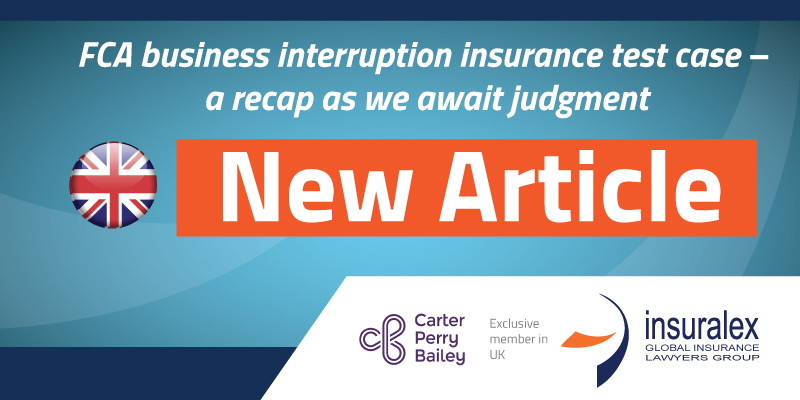
A summary of the background to the test case and the keys issues following the conclusion of the hearing
On 30 July 2020, the High Court hearing of the FCA’s business interruption insurance test case concluded. The FCA intends to resolve the uncertainty as to how business interruption insurance policies should respond to Covid-19 related claims by obtaining a declaratory judgment in relation to the meaning and effect of a representative sample of multiple policy wordings, underwritten by eight insurers. The judgment is expected to be handed down in September 2020 and will be legally binding on those eight, and will provide persuasive guidance for the interpretation of similar policy wordings used both within the UK and worldwide.
Background
The Covid-19 pandemic has had, and continues to have, a devastating effect on both health and economies across the world. Lockdown restrictions have caused significant losses to many businesses, which may look to their business interruption insurance policies for recompense. However, most business interruption cover is linked to property damage. As a result, losses related to business closures arising solely as a result of Covid-19, where no physical damage to property has arisen, are unlikely to be covered.
The coverage position is less clear in relation to businesses that have purchased ‘non damage’ extensions to their business interruption cover. Two common cover extensions relate to (1) the denial of access to insured property or (2) where a notifiable disease has occurred at or within a specified radius of the insured property. Many insurers have declined cover under extended business interruption policies for losses resulting from the Covid-19 pandemic. It is upon these non-damage policy extensions (and not cover arising from property damage) that the FCA’s test case focuses. The case was issued on 9 June 2020 and was admitted to the Financial Markets Test Case Scheme, which is for claims raising issues of general importance that require immediate court guidance.
The eight Defendant insurers who agreed to participate in the test case are: (1) Arch Insurance (UK) Ltd (‘Arch’); (2) Argenta Syndicate Management Ltd; (3) Ecclesiastical Insurance Office Plc; (4) Hiscox Insurance Company Ltd; (5) MS Amlin Underwriting Ltd (‘MS Amlin’); (6) QBE UK Ltd; (7) Royal & Sun Alliance Insurance Plc (‘RSA’); and (8) Zurich Insurance Plc (‘Zurich’). The court also allowed intervening claims by policyholder representatives, (1) the Hiscox Action Group and (2) the Hospitality Insurance Group. The 8-day hearing of the test case commenced on 20 July 2020 before Lord Justice Flaux and Mr Justice Butcher.
The key issues raised at the hearing are summarised below.
A. Prevention of access
Three key sub-issues were raised in relation to cover that is triggered by the prevention of access to the insured business:
(a) What level of prevention of access/hindrance is required or in other words, can a curtailment short of total closure still trigger cover?
(b) Is Government advice sufficient to trigger cover under policies requiring a ‘prohibition’ from a ‘public authority’?
(c) Can policies that require a prohibition (referred to at (b) above) that has been caused by an occurrence or incidence within a prescribed radius of the insured business be triggered by a nationwide disease?
The FCA argued for a wide interpretation in relation to the three sub-issues, whereas, unsurprisingly, the insurers advocated a strict interpretation of the policy wordings. Dealing with the respective positions on each sub-issue in turn, they can be summarised as follows.
- The extent of the prevention/hindrance
In the FCA’s view, neither the total closure of premises nor any physical obstruction is required to qualify as prevention of access under the policy wordings. They submitted that a partial closure, such as the closure of a restaurant, which could still provide a takeaway service, is sufficient to trigger cover. Further, they submitted that a hindrance to access preventing the business from operating as normal, such as the Government’s lockdown restrictions, also triggers cover.
The insurers submitted that a total cessation or suspension of the insured’s business was required to trigger cover. Whilst there are differences in the respective policy wordings as to what qualifies as prevention of access, i.e. some require an obstruction or a legal prohibition, the insurers were united in their view that it is solely the insured’s ability to access or use the insured property that is relevant, not the position of the general public.
- The role of the Government
In the FCA’s view, a prohibition with legal force was not necessary to trigger cover; the Government forbidding access was sufficient. They argued that policyholders would have been in breach of the law and policy terms and conditions had they chosen not to comply with the measures implemented by the Government. In its opening submissions, the FCA also addressed Zurich’s denial that the Government amounted to a public authority as contemplated by the relevant policy wordings, an argument which Lord Justice Flaux commented was “surprising”.
Insurers submitted that mere advice or guidance, which is not mandatory, is not sufficient to trigger cover. Different positions were adopted by the insurers as to which Government action triggered cover under the respective policy wordings. For example, it was submitted by RSA and MS Amlin that it was not until 26 March 2020, as a result of the Health Protection (Coronavirus Restrictions) (England) Regulations 2020, that the Government’s actions had sufficient legal force to trigger cover. In their view, earlier advice, guidance or directions were insufficient to meet the requirement under the policy wordings, whereas, Arch submitted that the advice given by the Prime Minister on 20 March 2020 and 23 March 2020 qualified as “actions preventing access” under the relevant policy wordings.
• Incidence/occurrence within a specified radius
The FCA submitted that policies should respond where Covid-19 is present within the prescribed locality of the insured business regardless of its nationwide presence. They submitted that it was the prevalence of the disease that caused the Government to implement a nationwide lockdown. Further, the Hospitality Insurance Group submitted that any wider exclusion could have been affected by way of a specific pandemic exclusion in the policy wordings.
Insurers’ position is that under the relevant policy wordings, the insured must show that, but for the outbreak of disease within the specified proximity, it would have suffered no loss. Insurers submitted that the UK Government’s actions were not caused by a localised incident or occurrence, they were a result of the nationwide epidemic. Therefore, the relevant polices would not respond as actions outside the prescribed proximity that caused the closure of the insured business would not fall within the remit of an insured peril. Insurers did, however, accept that it is possible on the facts for an insured to prove that such a localised lockdown, such as that in Leicester, was as a result of local occurrence of the disease.
B. Proving the presence of Covid-19
At the first case management conference, the court ordered that the trial will determine the type of evidence that would be sufficient for the insured to establish, on the balance of probabilities, the existence of Covid-19 within the prescribed proximity to the insured business. The FCA proposed that the presence of Covid-19 can be proven by statistical evidence (based upon reports by Cambridge University and Imperial College London). However, insurers have been unable to obtain expert evidence on the issue of prevalence of the disease and there was insufficient time to deal with expert evidence at the hearing. As such, it may be necessary to hold a further hearing on this issue in September.
C. Causation and loss
There are 3 key sub-issues relevant to causation and loss. These are:
(a) what is the effect if there are concurrent and interdependent causes of the loss?
(b) what is the correct counterfactual scenario to be applied to calculate the insured loss?
(c) what is the implication of a ‘trends clause’ on the insured loss?
• Concurrent causes of loss
Insurers rely on the decision in Wayne Tank and Pump Co Ltd v Employers Liability Assurance Corp [1974] QB 57, which established that there will be no cover where the loss has been caused by interdependent concurrent causes, which include an uninsured peril (for example, the epidemic in this case) as it cannot therefore be proven that the loss was caused by an insured peril. In the FCA’s view, the presence of Covid-19 in each locality is an integral part of one single broad and indivisible cause and it was the prevalence of Covid-19 that caused the implementation of the nationwide lockdown. The case law relevant to concurrent causes of loss was the subject of much discussion given the need to establish causation and the effect of trends clauses (discussed further below).
• The counterfactual scenario
Insurers argued that the court must compare the insureds’ actual position against a counterfactual scenario in which the insured peril (such as the particular restriction or local case of Covid-19) does not operate. They argued that many insured businesses would have experienced loss anyway, because the existence of the epidemic would have resulted in a downturn in trade, irrespective of the insured peril. In submissions, RSA relied on the example of the Scilly Isles (which it is agreed had not experienced a known case of Covid-19 but regardless had been subject to Government restrictions and closure) to argue that a causal link between the UK Government’s restrictions and loss could not be satisfied by the FCA.
It was accepted by insurers that the burden of proving another cause of the loss falls on the insurer not the insured. In the FCA’s view, the correct counterfactual scenario to be applied is one in which there is no Covid-19 and no resultant UK Government action. It would, in the FCA’s view, be wrong to ignore the insured peril in a counterfactual scenario but still have regard to the effect of Covid-19, which they say caused and is intrinsically linked with the insured peril.
• Trends clauses
Many (but not all) business interruption insurance policies include ‘trends clauses’ which are relevant to the calculation of the insured loss because they take account of the circumstances/trends of the insured business. Insurers argued that many businesses would have suffered in any event due to the Covid-19 epidemic. In support of their position, insurers rely on the decision in Orient Express Hotels v Assicurazioni Generali Spa (UK) (t/a Generali Global Risk) [2010] EWHC 1186 (Comm). This is an English case relating to the losses suffered by a hotel as a result of Hurricane Katrina in 2005. It was found that there were two independent causes of the loss, firstly, the damage to the hotel and, secondly, the wider damage to the surrounding area, which would have adversely impacted the hotels’ business anyway. In the circumstances, the insured could not show that the business loss would not have been suffered ‘but for’ the damage to the hotel.
The FCA submitted that the purpose of the trends clause is to look at matters that are extraneous to the policy – it should not be used to exclude the damage caused by the insured loss itself. Further, the FCA was critical of the prospect that a trends clause, which deals “merely with quantification of the loss” should enable insurers to subvert the causation test. The FCA submitted that the decision in Orient-Express Hotels is not applicable to the current test case, as it considered property damage, and was not a full re-consideration of the case but a limited appeal under s69 of the Arbitration Act 1996. Further, the FCA submitted that Orient-Express Hotels was based on a misunderstanding as to how an all risks policy operates, is incorrectly decided and should not be followed. The FCA argued that the Court of Appeal decision in Silver Cloud (P and C Insurance Limited v Silversea Cruises Limited [2004] EWCA Civ 769), which relates to a non-property damage trigger, is more relevant and should be applied. In this case, which considered the losses suffered by a cruise ship that had insured against loss of income caused by terrorist activity, it was held that that there was an inextricable connection between two concurrent causes of loss, the ‘9/11’ acts of terrorism in the USA and the state warnings issued in response. Both had been causative of the loss suffered.
CPB Comment
According to the FCA’s opening submissions, this test case has the potential to affect over 60 insurers with 700 types of policy and, it estimates, 370,000 policyholders. Unfortunately, we suspect that the judgment, when received, will not provide the much-needed clarity. Given the stakes for all involved, we suspect that the judgment will be subject to appeal. Indeed, the parties have already noted in the FCA Framework Agreement that the test case is a likely candidate for a leapfrog appeal to the Supreme Court. In the meantime, policyholders should ensure that they have complied with any notification requirements for policies which may provide cover for business interruption losses arising from Covid19.
Carter Perry Bailey has significant experience in reviewing business interruption insurance wordings. We are able to advise on whether Covid-19 losses are likely to be covered under the terms of a policy, as well as offer advice on policy wording for both insurance providers and policyholders that are considering changes to their standard cover.
 Bernadette Bailey
Bernadette Bailey
Partner
T: 0203 697 1903
M: 007887 645263
E: bernadette.bailey@cpblaw.com
 Dean De Cesare
Dean De Cesare
Associate
T: 0203 697 1912
M: 0 07425 355252
This information has been prepared by Carter Perry Bailey LLP as a general guide only and does not constitute advice on any s pecific matter. We recommend that you seek professional advice before taking action. No liability can be accepted by us for any action taken or not as a result of this information, Carter Perry Bailey LLP is a limited liability partnership registered in England and Wales, registered number OC344698 and is authorised and regulated by the Solicitors Regulation Authority. A list of members is available for inspection at the registered office 10 Lloyd’s Avenue, London, EC3N 3AJ.



 Bernadette Bailey
Bernadette Bailey Dean De Cesare
Dean De Cesare
